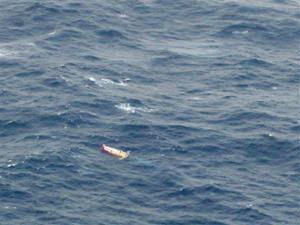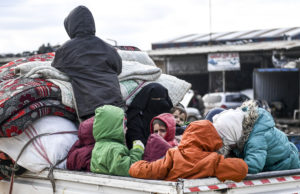When Adults Help Kids Flirt With Death
Abby Sunderland was ill served by the grown-ups around her. Had the talented sailor suffered just a bit more bad luck at sea, she might not be alive to anticipate her 17th birthday.Abby Sunderland was ill served by the grown-ups who facilitated the record-seeking voyage that placed her in such grave peril.
Thousands around the world were relieved to learn late last month that Abby Sunderland, 16, is safely back in the bosom of her family in Southern California.
If you weren’t one of those, at this moment you’re probably asking, “Who?”
Abby Sunderland, the international hero and role model to admirers near and far, that’s who. The girl whose name fetches almost 7 million hits on Google, that’s who.
The teenager—called an adventurer by some and a daredevil by others—returned to her home in Thousand Oaks, Calif., on June 28 after being plucked out of the Indian Ocean following an accident that terminated a colossal solo voyage. She and her 40-foot sailboat had ended up in quite a pickle when a heavy sea snapped off the racing vessel’s 60-foot mast, leaving, as she later told a throng of reporters in California, a 1-inch stub.
The mast broke when the sloop Wild Eyes encountered a 30-foot wave during a squall and turned upside-down, briefly knocking the young sailor unconscious. Largely because of the emergency radio beacons onboard, she was rescued two days later. But during the long hours when there was no way for her to tell anyone she had survived, anxiety over her fate ran high. (A few pessimists declared she probably was dead.)
Abby’s brother Zac—who last year became the first person under the age of 18 to complete a solo circumnavigation—said at the time: “Everyone’s praying. It’s kind of a waiting game at this point. The main hope is to get a plane out there.”
It’s no exaggeration to say that even with the access to electronic technology she had before and after the mast was lost, Abby Sunderland was in a perilous state, one that easily could have turned fatal there in the Indian Ocean 2,000 miles from land.
Sunderland set out early this year in the hope of becoming the youngest person to circumnavigate the globe solo and nonstop. She had covered 12,000 miles when the mission ended so suddenly and dramatically. But before she reached that point her effort to complete the voyage without stopping had long been frustrated. Soon after she set sail from Marina del Rey, Calif., she needed to make port in Mexico to deal with an equipment problem, and later she stopped in South Africa.
On abbysunderland.com — “The official website of Abby Sunderland … and her quest to become the youngest solo circumnavigator” — there was a message this month that the teenager posted during her journey: “My name is Abigail ‘Abby’ Sunderland and it is my dream to sail around the world. I’ve been around the water and on boats since I was 6 months old. I began single-handing when I was 13. I had this idea several years ago, even before my brother, Zac Sunderland. But watching him do it in 2009 made me realize my dream could come true with lots of hard work, support and perseverance. In January 2010, I set sail around the world on “Wild Eyes”, an Open 40 racing sailboat. I am attempting to become the world’s youngest solo circumnavigator! This will be quite the adventure!”
Her prediction in that last sentence certainly proved to be correct, and her exclamation point at the end certainly proved to be called for.
Early in July on her website (now changed) there was an aerial photograph of the dismasted boat, which was emblazoned with a company name, Shoe City, in large capital letters. The picture was taken when the disabled craft was at the mercy of currents, and within the photo was the printed question “Where is Wild Eyes?” A mouse click on the picture took one to an undated map and a caption: “Wild Eyes is drifting eastwards at approximately 24 nautical miles per day towards the Australian coast. This map shows its estimated location.”
A guest at the site could click on a device to expand the map, and that yielded an interesting perceptual result. As successive clicks enlarged the frame step by step, the indicator of the boat’s changing position was dwarfed ever more by a surrounding expanse of blue ocean. For seemingly countless miles, one saw nothing but water. A few more clicks, and two specks of land appeared in the image, and then, at last, Africa, Australia and Antarctica. Although it was nothing but a map, its effect on at least this viewer was striking: The portrayal of sheer physical isolation was intense.
In assessing what happened to Sunderland, it fairly boggles the mind that adults were involved in placing this child in such a situation, however precocious, smart, strong, talented and ambitious she might be. After all, we are talking about a girl who doesn’t yet have a driver’s license or a high school diploma and who wouldn’t be old enough to legally enter a California nightclub until the autumn of 2014.
On her website, Sunderland thanked “family, friends, supporters, sponsors and Team Abby” for helping to make the adventure possible. On the word sponsors was a hyperlink that enabled site visitors to see the assembled logos of more than two dozens concerns that presumably had provided money or some other support for the attempt.
Besides Shoe City, the sponsors named on the website included a movie theater chain, a marketer of sunglasses, a camera retailer, several sailing-related companies and a number of food-related operations, among other businesses. In a June 18 article the Los Angeles Times reported that the sponsors had collectively contributed $100,000 to $200,000. Also, according to the newspaper, Laurence Sunderland, the father of Zac and Abby, says the family put a quarter of a million dollars into the ocean-spanning voyages of the two teenagers.The relationship between the sponsors and Abby was probably not much different in principle from the one that exists between corporate benefactors and the race car teams that slather company names over their vehicles. Shoe City and at least some of the other sponsors—their halos of altruism notwithstanding—surely figured to attract favorable attention to themselves through public association with the girl’s voyage.
The shoecity.com website early this month featured a large photo of Wild Eyes — alternating with two images promoting footwear — that showed the boat under sail with the Shoe City sign in full view; touching the bow was an inset picture of the photogenic teenager, next to the words “ABBY SUNDERLAND, YOU ARE OUR INSPIRATION!”
Considered strictly in terms of business promotion, the decision of the companies to be sponsors was reckless and foolhardy. In the end, they lucked out: Abby made it back in one piece. Had she not, the Shoe City chain, especially, would have faced a PR debacle: TV networks might have been broadcasting images of her grieving family within seconds of mentioning the company’s name, or might have been showing scenes of human tragedy at sea with the boat’s Shoe City sign looming large. The saying that “all publicity is good publicity” isn’t always true.
At this moment, Wild Eyes and its Shoe City ad well may rest at the bottom of the Indian Ocean. After Sunderland’s rescue in June, the then-unoccupied vessel was expected to sink or be sunk.
Aside from business considerations, the sponsorship by Shoe City and others can be saddled with adjectives much harsher than reckless. The first that comes to mind is unconscionable.
To help a minor undertake a premeditated feat that exposes her to severe risk of death … well, it approaches the territory of exploitation and abuse. The adults around Sunderland were not helping her compete in a bicycle race, or go skiing at Mammoth Mountain, or drive up Interstate 5 to Sacramento — all of which could, of course, result in injury or loss of life. They were facilitating a girl’s desire to go on an ocean trip, alone, that would take her through treacherous waters off the southern tips of South America and Africa and, she hoped, across the seemingly unending Pacific, where countless sailors and aviators have been gobbled up.
When the wave rolled her boat on June 10 and caused Sunderland to momentarily black out, it was only through the greatest good luck that she did not perish. Had she not been below deck, she might have been hurled into violent, frigid water. Safety harnesses and tethers have been known to come apart, and even intact safety gear has failed to save some sailors struck by a monstrous wall of water. And that doesn’t even get into the possibility of the boat’s hull breaking under the sea’s assault, which fortunately it didn’t. If that had happened, the girl might have had to take to a life raft, if she could manage to do so.
Contrary to some arguments, the risks in Sunderland’s venture can in no way be equated with the real but lesser dangers that most teenagers routinely face. Whatever the chances of dying on a movie date or a trip to school (in any part of any city), they are microscopic in comparison with the chances of dying on a solo voyage around the world. If you don’t believe that, ask Lloyd’s of London to quote you insurance policy prices for each.
Ironically, Sunderland’s attempt to set a record ended up almost killing someone who never will bask in the light of intercontinental celebrity or contemplate being the star of a reality show. The captain of the French fishing boat that rescued the girl fell into the ocean during the transfer and was saved only with considerable difficulty.
Here are some questions to ponder in considering the odd case of Abby Sunderland. If it is OK to help a 16-year-old minor defy death in this way, would it be OK to do the same with an 11-year-old? And suppose there was a crackerjack sailor who was only 8 years old. Would you be above blame if you helped that kid flirt with death just because he or she really really really wanted to set a record? Just where should the lower age limit lie? Should there even be a lower age limit? Is a relative’s assertion that a child is a great athlete reason enough to say, “Go for it, Honey”?
Laurence Sunderland discounts the role of age in his daughter’s voyage. “If people are looking at age, they’re looking at the wrong thing here,” he said last month. “Age is not a criteria. Abby is a fine sailor. I’ve never advocated this for 16-year-olds. I’ve advocated this for experienced sailors.”
There can be no doubt that Abby is a skilled sailor and that she isn’t the average teenager. But it isn’t rare for a parent to overrate the abilities of an offspring. In addition, talent and experience are beside the point here: If they were a dependable shield, no top-rated race car driver would ever be killed on a track and no seasoned power boat pilot would ever die during competition. To say one’s child is exceptional doesn’t mean anything in this argument.
Although there has been public debate about whether laws were violated in preparing for and carrying out Abby Sunderland’s aborted mission, to my knowledge the matter hasn’t been considered by officials. Maybe we need laws that more clearly apply to adults conspiring with children to involve them in perilous deeds.Regardless of how they are enforced, more than a few laws regulating interactions between adults and children are on the books. Also, there are many laws designed to protect minors from themselves. In the U.S. and elsewhere there are age restrictions on buying or using booze, tobacco and other potentially dangerous items and substances. These laws center on the notion that at some young ages, a person is not equipped to make good decisions regarding potential danger. The laws say, in effect: Later, youngster — you can do dangerous (but legal) things later if you decide to. The impulse behind the laws is found not in sophisticated interpretation of legal intricacies but instead in the common-sense, day-to-day experiences of personal, familial and societal life.
Last year, a court in the Netherlands stepped in to prohibit a 13-year-old girl from attempting to become the youngest person to sail solo around the world. Laura Dekker, now 14, was made a ward of the state to prevent her from setting out on the voyage, a proposed exploit supported by her father. Dutch judges extended the state supervision of the girl last month, just days after Abby Sunderland was rescued.
Laura Dekker’s father obviously had found a way to justify to himself his support of the child’s plan. Similarly, Abby Sunderland’s parents apparently managed to convince themselves that nothing was amiss in agreeing with their teenage son and then their teenage daughter that circling the globe alone in a sloop was a worthwhile endeavor for a minor.
The father, Laurence, told the L.A. Times, “It’s about a passion for sailing and loving your kids so much you want to be part of their dream.”
At one point the family dream seems to have included reality television. The Wrap website reported June 15: “Before [Abby’s] trip reached its premature end, the Sunderland family signed a contract to work on ‘Adventures in Sunderland’ with Magnetic Entertainment. The show would have featured the entire family. … On Monday, Abby’s father, Laurence Sunderland, said he had cut ties with Magnetic. … ‘There is no show at this time,’ he told reporters, ‘nor will there be.’ ”
That same week the elder Sunderland appeared on television’s “Larry King Live” and in response to a question from King rejected reports that Abby’s voyage had been aimed at getting a reality show. “That’s absolutely ridiculous,” the father said. “My passion is first and foremost for my children and their endeavors. And [the claim is] absolutely, totally ridiculous and totally unfounded.” He did say that five cameras had been aboard Wild Eyes and that Abby had been filming herself.
Understandably, the Sunderland family has not taken kindly to some of the criticism it has suffered. The parents issued a statement saying: “To hear the intensity of the personal hatred spewed by some in the media and on blogs was shocking to us. Abby should not be subjected to these hurtful attacks against members of her family, especially as what was being said was based, at best, on twisting facts out of context and, at worst, on total fabricated lies.”
Certainly this family—admired by many for being close-knit and professing born-again Christian values—does not deserve to be a target of hatred. But neither should its heavily publicized actions (Abby has hired a PR/talent management firm) be above question or well-grounded criticism.
Under a rain of disapproval that includes being named “worst sports father of the year” by one website, Laurence Sunderland says he went along with Abby’s plan only after opposing it initially. An excerpt from the Larry King show’s transcript:
KING: But she’s a minor at 16…
SUNDERLAND: Absolutely.
KING: You could have prevented it.
SUNDERLAND: I could have prevented it.
KING: You said you originally tried to dissuade her.
SUNDERLAND: Absolutely.
Message to parents: If your teenager keeps pestering you, telling you that you just gotta let her do something that could kill her, it’s fine to knuckle under. Saying “no” might cause unhappiness.
Several months ago, I was taken aback by a film documentary that I saw on a cable network. It concerned a 15-year-old engaged in so-called extreme skiing on a French mountain. One approving article on the movie finds no fault with what the boy did, maybe because, as it notes, he had “the help and guidance of an exclusive circle of big mountain skiers.”
One more case of adults colluding with a child to expose him to extreme danger.
I don’t doubt that the “help and guidance” the adults offered reflected great wisdom about skiing and mountain safety, but I suspect that their words would be of little benefit if an avalanche were a few yards away or after a skier had started to tumble down a thousand-foot, nearly vertical slope.
In the case of the young “extreme” skier, his dad couldn’t be criticized for not acting to stop the teenager from venturing out on rock-strewn inclines that would give nightmares to most people: The father, a celebrated skier, had been killed at age 30 while doing his thing on the same French mountain nine years earlier.The standard for underage derring-do shouldn’t be whether the minor survives. That is of towering importance, and caring people will always be joyful when a kid ends up unscathed, but a larger societal issue is in play: that of constructively guiding a child toward adulthood, toward a stage where he or she is fitter to make life-and-death decisions.
In 2005 The Washington Post published an article headlined “Brain Immaturity Could Explain Teen Crash Rate; Risky Behavior Diminishes At Age 25, NIH Study Finds.”
A National Institutes of Health study suggests that the region of the brain that inhibits risky behavior is not fully formed until age 25, a finding with implications for a host of policies, including the nation’s driving laws.
“We’d thought the highest levels of physical and brain maturity were reached by age 18, maybe earlier — so this threw us,” said Jay Giedd, a pediatric psychiatrist leading the study. … That makes adolescence “a dangerous time, when it should be the best.” …
Teenagers are four times as likely as older drivers to be involved in a crash and three times as likely to die in one, according to the Insurance Institute for Highway Safety.
That would seem to speak for itself.
Anytime someone raises the question of whether adults are doing enough to protect children from their own rash decisions, howls arise across a wide spectrum. Some people complain that children, especially American children, are overprotected and aren’t allow to adequately challenge themselves. Others claim that any call for better protection of minors is the work of Big Brother, who wants to control every aspect of life and to sap initiative in a scheme to produce a weak, docile population. Still others see a creeping nanny-ism that would turn boys into sissies, or force girls back into kitchens where they would have no access to achievement in sports, business and other activities out of the home.
Can protective attitudes have bad results if carried too far? Definitely. If carried too far. A minor is not a delicate hothouse flower that must be kept inside a stifling environment designed to ward off every threat, risk and danger. But how can it be anything but tragic when a life is prematurely and needlessly uprooted?
In 1996 there was a child named Jessica Dubroff who wanted to become the youngest person to pilot an airplane across the United States. She needed a booster seat in order to be high enough to see out of the cockpit. Despite media hoopla over her record attempt, the 7-year-old apparently did not always fly the craft. No matter. The media were on the case. Doing their job, however wrongheaded that job may be at times.
On April 11, 1996, about 24 hours after the bid for the record began, Jessica, her dad and a flight instructor took off from Cheyenne, Wyo., reportedly with the instructor at the controls. Need I say what happened?
Mainly as a result of that day’s three deaths, Congress soon passed the Child Pilot Safety Act, which imposes restrictions on underage pilots “attempting to set a record or engage in an aeronautical competition or aeronautical feat.”
Jessica would be 22 years old now.
I’m sorry you never had a chance to grow up, little girl.
Requiescat in pace.
|
T.L. Caswell was on the Los Angeles Times editing staff for more than 25 years and now edits and writes for Truthdig. |
Your support matters…
Independent journalism is under threat and overshadowed by heavily funded mainstream media.
You can help level the playing field. Become a member.
Your tax-deductible contribution keeps us digging beneath the headlines to give you thought-provoking, investigative reporting and analysis that unearths what's really happening- without compromise.
Give today to support our courageous, independent journalists.






You need to be a supporter to comment.
There are currently no responses to this article.
Be the first to respond.